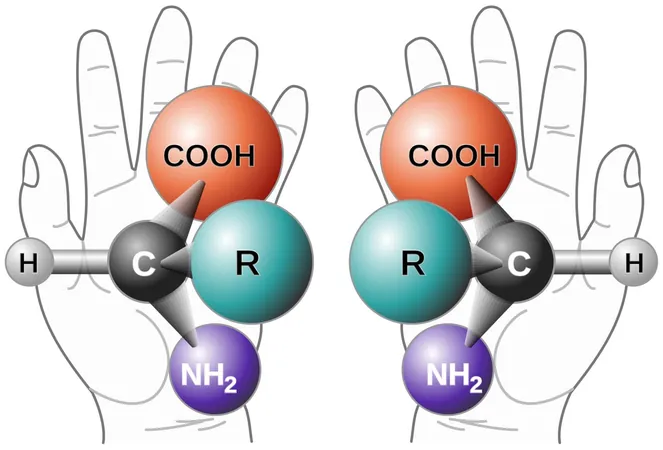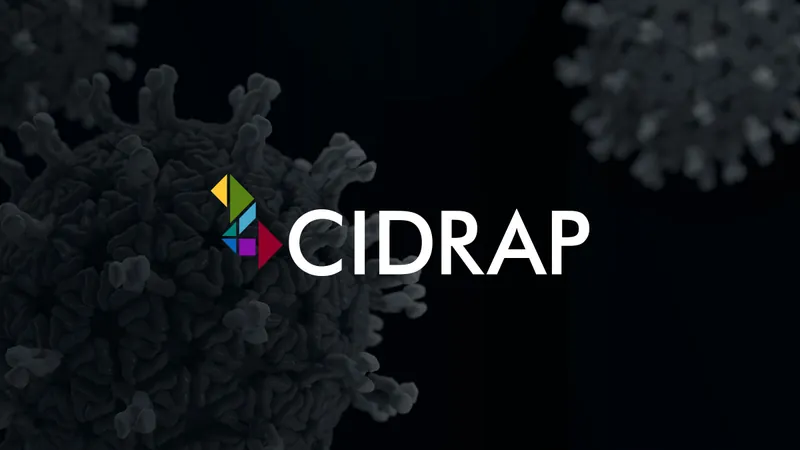
Revolutionary Study Confirms Chirality's Impact on Nuclear Spin Coupling Strength!
2024-10-09
Author: Rajesh
Groundbreaking Study Reveals Connection Between Chirality and Nuclear Spins
A groundbreaking study from researchers at prestigious institutions including UCLA, Arizona State University, Penn State, MIT, and Technische Universität Dresden has unveiled a fascinating link between chirality—or molecular handedness—and the strength of coupling between nuclear spins. This research, published in Nature Communications, challenges long-standing beliefs that chirality had no effect on spin coupling, opening up new avenues for exploration in both chemistry and biology.
Findings on Chiral Molecules
The researchers found that in chiral molecules, whether left- or right-handed, nuclear spins tend to align in a consistent direction specific to their chirality. Notably, in molecules with opposite chirality, such as right-handed forms, the nuclear spins align in distinctly different orientations. This groundbreaking revelation is set to alter the fundamental understanding of molecular interactions and could lead to significant advancements in various scientific fields.
Understanding Nuclear Spin and Spin-Spin Coupling
The nucleus of atoms, comprised of protons and neutrons, exhibits a characteristic known as "spin," which generates a magnetic field akin to that of a bar magnet. When these magnetic nuclei are positioned closely, they influence each other's spins—a phenomenon referred to as spin-spin coupling. Traditionally seen as a uniform principle, the new study demonstrates that chirality can subtly yet significantly influence these couplings.
Implications of the Discovery
The implications of this discovery are immense. By understanding how handedness affects nuclear spin interactions, scientists could potentially harness this knowledge to explore the interactions of molecules with varying chiralities. This could yield insights into electron spin roles within chemical reactions, providing a new perspective on molecular behavior.
Historical Context of Chirality
Historically, chirality has been acknowledged as a fundamental property of certain molecules, where identical atomic compositions can exist in two mirror-image forms, called enantiomers. However, it was previously thought that this property bore no influence on magnetic interactions. The new findings suggest otherwise, indicating that chirality may play a much larger role than previously anticipated.
Researcher's Insights
"This research is a first-of-its-kind demonstration that purely magnetic effects can influence nuclear spin-spin couplings," said lead researcher Professor Louis Bouchard from UCLA. "We were amazed to discover that the chirality of a molecule directly affects the strength of its spin coupling."
Practical Applications in Chemical Reactions
What's more, the study hints at practical applications in chemical reactions, suggesting that techniques sensitive to nuclear spins could serve as non-disruptive sensors for monitoring reactions involving chiral groups. This could revolutionize how scientists observe and understand chemical processes as they unfold in real-time.
Future Research Directions
As Professor Bouchard aptly points out, "We need better methods to probe the state of electrons and spin in chemical and biological systems. Our findings equip researchers with enhanced tools to explore and manipulate spin states during reactions, presenting limitless possibilities for future experiments."
Impact on Various Fields
Multiple fields, including drug development and materials science, may benefit significantly from these revelations. The ability to selectively study interactions based on chirality means chemists could fine-tune reactions to achieve desired outcomes, potentially leading to innovative breakthroughs.
Conclusion: A New Era in Molecular Chemistry
Get ready for a new era in molecular chemistry where understanding the subtle nuances of chirality could reshape how we decipher complex molecular behaviors! Keep an eye on future developments—this could be just the tip of the iceberg!



 Brasil (PT)
Brasil (PT)
 Canada (EN)
Canada (EN)
 Chile (ES)
Chile (ES)
 España (ES)
España (ES)
 France (FR)
France (FR)
 Hong Kong (EN)
Hong Kong (EN)
 Italia (IT)
Italia (IT)
 日本 (JA)
日本 (JA)
 Magyarország (HU)
Magyarország (HU)
 Norge (NO)
Norge (NO)
 Polska (PL)
Polska (PL)
 Schweiz (DE)
Schweiz (DE)
 Singapore (EN)
Singapore (EN)
 Sverige (SV)
Sverige (SV)
 Suomi (FI)
Suomi (FI)
 Türkiye (TR)
Türkiye (TR)